A crocheted snood can become a necessary accessory for both an adult and a child. Making it yourself is not particularly difficult. To do this, you will need yarn, the ability to knit and a little free time.
What is a snood?
A snood is a scarf of an unusual shape, crocheted or knitted in a circle. Its versatility lies in the fact that with its help you can transform almost any image. That is, get the most interesting thing that gives comfort and coziness even in cold weather, especially it looks stylish and fashionable.
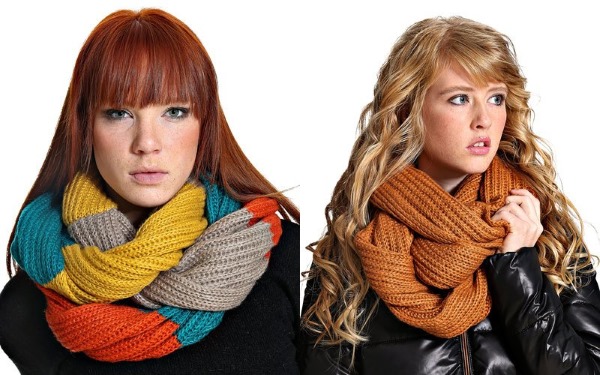
The history of its appearance goes back to the distant past. Back in the forties, special hairnets were made in the shape of a pipe, and in the 80s, every fashionista had a scarf-collar in her wardrobe. They are considered the ancestors of modern snoods.
The desire to have a stylish appearance and feel comfortable in any weather has led to many needlewomen starting to knit such accessories for themselves and their loved ones.
As an approximate calculation of the amount of yarn required and the size of the product, you can use the tables below:
| Who is the snood for? | Age, years | Product width, cm | Product length, cm | Number of skeins, pcs. |
| Child | 4 - 6 | 16 | 98 | 1 |
| Child | 7 – 9 | 115 | 115 | 2 |
| Teenager | 10 – 15 | 21 | 124 | 2 |
| Adult | Unlimited | 22 | 142 | 3 |
New models of snoods for boys and girls
In principle, all snoods are knitted from a regular scarf, then sewn into a ring, or circular knitting. Modern fashion classifies a large number of variations on this theme. For example, when knitting, the scarf is not closed at the edges, but is fastened with buttons or hooks.
Also a new and original solution - a scarf in the form of a Mobius strip, that is, twisted along the canvas. This allows the collar to fit more tightly to the neck, creating more warmth and comfort.
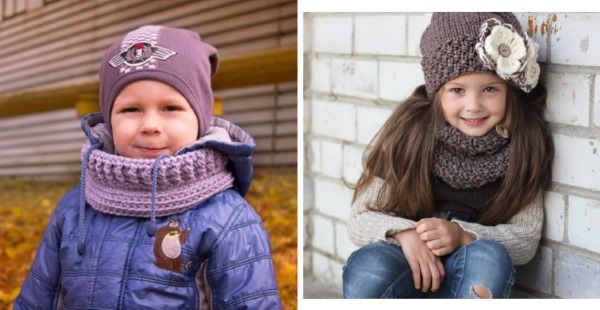
It is desirable to crochet a snood for boys more voluminous than women's, the knitting in them is larger and more textured. After all, any man, even if he is still small, appreciates practical things, and beauty is secondary. This must be taken into account when choosing patterns for work on its manufacture. It is better to direct tightly, in a circle, without using any accessories and decorations.
The peculiarity of creating things for little princesses is that girls always like to stand out - you can decorate the snood with knitted flowers, leaves, embroider with beads, rhinestones. It is possible to use fringe, openwork knitting.
Selecting yarn
You can crochet a snood from almost any yarn.

The only condition in this matter is the thread should be very soft and gentle, because your face will be in constant contact with it and using coarse, stiff yarn can irritate the skin.
Wool - retains heat very well, but is very prickly. The scarf will be warm, but not comfortable. It is advisable to replace it with semi-wool - merino with acrylic.
Children's snoods differ from adult ones only in size. You should not make very large accessories, they will only hinder the baby in his movements. Therefore, the yarn is not the thickest and most voluminous, and it itself should be very soft, so as not to harm the baby's delicate skin with friction.
Thread material
The time of year dictates the rules of choice.
Winter will require voluminous, warm scarves made from yarns such as:
- Mohair.
- Cashmere.
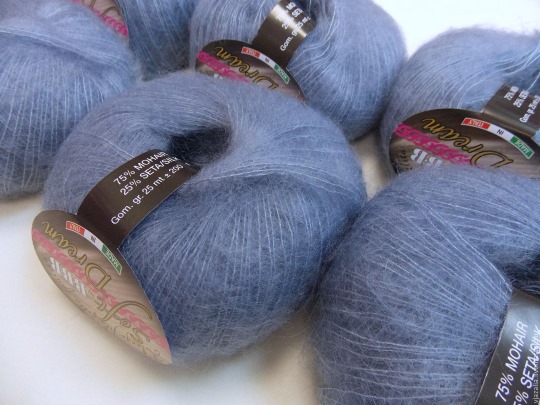
- Angora.
- Acrylic mixed with wool.
You can also crochet a demi-season snood. For this you will need thinner yarn - cashmere, acrylic.
When creating summer scarves that only decorate the image, there is no need for warm types of threads, so the following threads are used:
- Cotton.
- Viscose.
- Microfiber yarn.
- Linen.
- Bamboo.
Color
The fabric looks excellent, knitted from both plain and melange yarn.
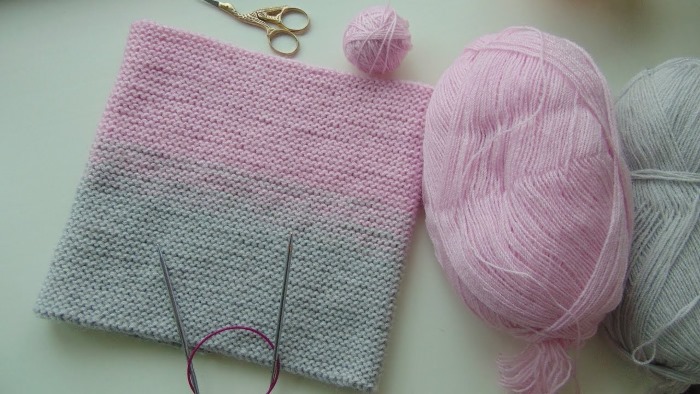
You can choose shades that match each other and create a beautiful snood with a gradient or striped one. Sectionally dyed thread will add a twist to the product.
Yarn thickness
This parameter will directly depend on the purpose of the snood. For walks in the cold season, you need to take thicker threads - the scarf should warm. Autumn-spring options will be thinner, more delicate, and therefore you need to take the appropriate yarn for this. Summer snoods are intended only for decoration, they will not warm - the thinnest threads will do.
Calculating the amount of yarn
To create a high-quality and beautiful thing, at the very beginning of the work you need to do a rather boring, but very important task - calculate the amount of yarn that will be needed to knit the selected snood model.
It is easier when it is made according to a ready-made description - this is good because everything has already been calculated and you do not need to invent anything yourself. But even in this case, it is not guaranteed that the calculated dimensions will fit - each person is individual.

Just as sewing requires adjusting patterns, crocheting requires adjusting yarn consumption. And when knitting starts from scratch, without having ready calculations, this part becomes simply necessary!
Each yarn has its own calculation algorithms and unique properties, based on which calculations are made.
- Thick threads are required in much smaller quantities than thin ones.
- Threads with low twist are much more economical to use.
- The stockinette stitch will require less yarn than the braid stitch.
- Knitting openwork patterns requires the least amount of thread.
- The thickness of the hooks also plays an important role - the thicker they are, the less yarn is consumed. But they are not used everywhere - only when the thickness of the thread allows it.
That's why, At the very beginning of creating a snood, it is necessary to decide several questions about the details:
- What pattern to knit with.
- What yarn?
- Hook size.
The most accurate way has always been to make samples. It should be knitted with the same pattern as the main fabric. Be sure to wet it and iron it.

Then move in one of two directions:
- The first is calculating the weight of the threads. By measuring the area of the entire scarf and multiplying it by the mass of the sample, and then dividing by the area of the knitted piece, you will get the required indicator.
- The second is calculating the footage. The process is labor-intensive and complex, but effective. You need to divide the working thread into meter-long sections using a marker, knit a sample, not forgetting to count the meters. Also process it as in the first case, and measure the area. You will also need the area of the planned result.
All that remains is to calculate the number of meters by multiplying the area of the whole snood by the length of the thread used for the sample, and then dividing the resulting number by the area of the sample.
The number of threads in the spools is easier to calculate by the footage - this way you can immediately purchase the required number of skeins for work.
Choosing a hook
You can crochet a snood in various ways - with knitting needles, using a hook, or a fork. When crocheted, they are denser, hold their shape better and retain heat. For summer options, there are a huge number of patterns that allow you to create masterpieces with this tool!
The yarn packaging always indicates the numbers of the appropriate tools., but sometimes it happens that a thread is formed without packaging or with damage that does not allow determining the size.
For such cases, a proven method of selecting a hook has been invented - you need to place the thread in the groove of the hook. If the compatibility is ideal, the thread will fill it, placing itself in the right position.

In the description of the pattern, it is sometimes recommended to select a hook that is smaller or larger in size. – in this case, the fabric will have a denser or looser texture.
Simple crochet snood: diagram, description
Even the most inexperienced needlewomen can create a crochet snood. It is quite easy to knit - stock up on threads, a hook and patience.
To create you will need:
- 450 g semi-wool (50% merino wool, 50% acrylic).
- Hook No. 5.
The length is calculated as follows: the distance from the chin to the crown of the head is measured with a measuring tape. The resulting value is multiplied by the number of planned wraps. The result is the length of the finished snood.
In this situation, the accessory is knitted with a fillet mesh. Its width is 35 cm, length is about 140 cm. The work will be done in a circle, without using lifting loops and half-columns to connect the rows according to the attached diagram.
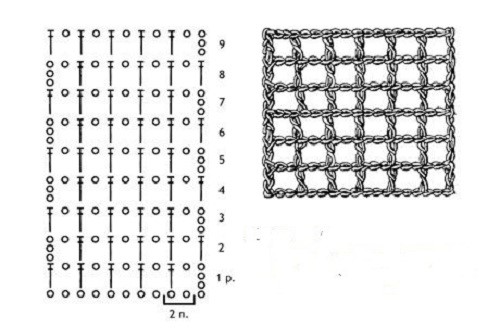
At the beginning of the work, it is necessary to dial a chain of air loops equal to 140 cm. Then count 7 loops from the last one on the hook, and in the seventh knit a “column with one yarn over. Continue with an air loop and through one loop knit another 1 double crochet”. In this way continue until the end of the row, fix the last one in the fifth air loop at the beginning of the row.
The second row and all subsequent ones are knitted in the same way as the first filet - to the intended width. At the end of the work, a half-column is knitted, the thread is cut off and hidden in the edge - a braid.
For beginning craftswomen, this method is the most optimal. After mastering basic knitting techniques, they will be able to move on to complex patterns.
Voluminous snood crocheted from thick yarn: diagram, description
A voluminous scarf, intended for the winter season, can be knitted with a pattern that includes "lush" columns. The yarn chosen for this is thick - it will give the snood a lush and cozy look, and will also warm you up perfectly.
The thread consumption is significant - a lot of it is spent on "lush" columns. Their use brings airiness and coziness. Such a pattern excludes knitting a long scarf - already voluminous, it turns out very warm.
The following dimensions would be ideal for it:
- Length 38 – 40 cm.
- Width – 30 – 32 cm.
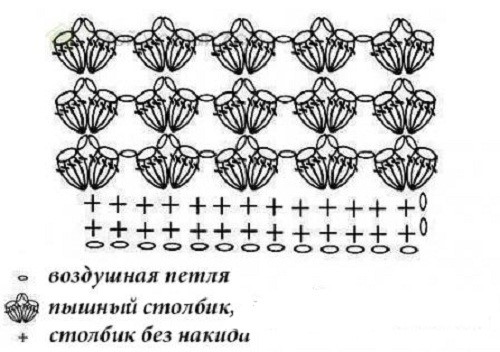
It is advisable to choose yarn that contains a high content of acrylic. - it holds its shape well and has the property of retaining heat. The size of a suitable hook is 4.5 or 5.
Step by step knitting:
- At the beginning of the work, a chain is made consisting of 80 air loops, which are closed in the form of a ring with a half-column.
- In the second and third rows, over each loop of the previous row, single crochets are knitted, closing the row with a half-column.
- The next one starts with a lifting chain stitch, and then knitting a “lush” column, two chain stitches, a “lush” column - in the first column of the previous row, a chain stitch, skipping two columns and from here the repetition goes from (to) throughout the entire row to the end, closing with a half-column.
- From the fifth to the twenty-fifth row, a “lush” column is knitted, 2 air loops, a “lush” column in the arch of the previous row - the entire row is knitted in this way.
- In the twenty-sixth row, single crochets are made into arches of two loops, alternating them with two air loops.
- The last 2 rows - single crochet into each column of the previous row.
Snood crocheted with relief columns: diagram, description
Products knitted using relief stitches have a very beautiful and textured appearance. A lot of thread is used for such patterns.

For such a snood you will need 200-250 grams of semi-woolen or acrylic yarn. For example, for this scarf you will need 300 grams of yarn, knitting is done with hook No. 4.5. The length of the circumference is 95 cm, and the width is 35 cm.
How to knit:
- Knitting begins with a set of air loops - you should get a chain equal to the length of the scarf.
- In the first row, the hook is inserted into the fifth loop, the columns are tied with a yarn over into the chain loops. For lifting, 3 air loops are collected.
- In the second row and all subsequent ones, continue knitting, alternating double crochets and relief stitches, following the pattern.
- Rows 2 and 3 are repeated throughout the knitting. It is necessary to take into account that all previous double crochets are knitted with relief double crochets and, on the contrary, relief double crochets are knitted with double crochets.
- Once you have reached the desired width, you can stop. Sew the loose ends into a ring, and steam and dry the scarf.
Beautiful crochet snood with buttons and fringe: diagram, description
It won't take much time to create a warm and stylish accessory. It's best to use thin semi-wool for knitting, as its pattern is quite dense, and a thick thread will add extra coarseness to the fabric.
To do this, you need to prepare the following:
- Yarn - about 250 g.
- Several decorative buttons of suitable size and color.
- Needle and thread for sewing.
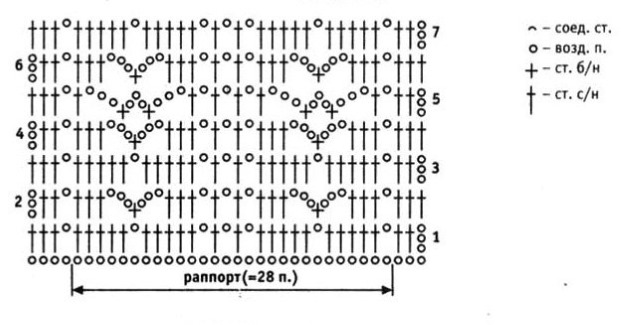
It will be more convenient to knit with hook No. 5. Also, do not forget about scissors, they will be needed to make the fringe. The size of the snood is approximately 140 by 17 cm. At the beginning of the work, you need to dial 38 air loops (the width of the scarf is approximate, based on the thickness of the threads). If it turns out wider, reduce the number of loops on both sides, otherwise, on the contrary, add.
Knitting follows the pattern until the scarf is knitted to the desired length. Cut the working thread, hide the "tail". The snood is knitted, it remains to decorate it. To do this, take the remaining yarn and cut it into pieces of 25 cm. Using a hook, pull each folded piece of yarn into the spaces between the double crochets and secure with a loop.
Place the ends of the scarf on top of each other, overlapping each other, with an overlap of no more than 2 cm. Sew on the buttons, having first calculated equal intervals between them.
Openwork crochet snood: diagram, description
As mentioned above, fashionistas are ready to do a lot to achieve stylish and bright looks. That is why There are summer versions of snoods made from the thinnest threadsThey don’t warm you up at all, but they add a certain romance, tenderness and femininity to your appearance.
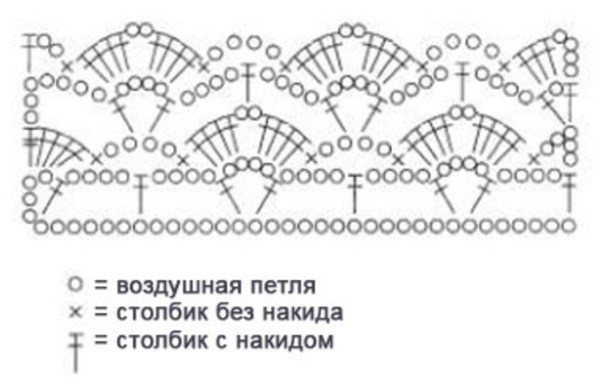
This is done in the following way:
- Select the thinnest “summer” threads, hook No. 1 or 2.
- The patterns are taken for knitting lace with the most airy pattern, because light lace has many arches and holes. The most common and well-known is the "Shell". There is nothing particularly complex or intricate in it, and it is composed of air loops and double crochets.
- In the first row, chains of air loops and double crochets are knitted, which together form arches. Next, combinations of double crochets and air loops are knitted here.
Classic snood for boys: diagram, description
You can crochet a snood as your first project. The easiest way is to choose a simple pattern.The knitting direction is circular, the length of the scarf will be 130 cm, that is, 2 turns. You can reduce the size if you wish.
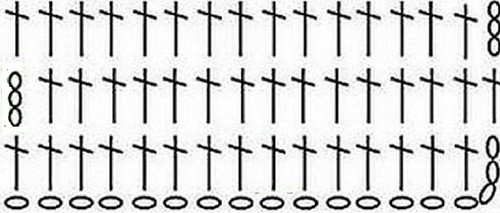
This laconic scarf will appeal not only to the fair sex, but also to boys. Knitted from thick threads of natural shades with a hook No. 6, it will perfectly fit into a man's wardrobe.
The procedure is as follows:
- Cast on 130 stitches and join the chain into a ring with a half-column. It is important that the chain does not twist - this will create a very unsightly knitting edge.
- Next, knit double crochets in each loop of the chain until the end of the row.
- Connect the lifting loops and the last post using a slip stitch.
- In the second row, cast on 3 lifting loops and continue knitting with double crochets over each column of the previous row.
- Continue knitting until the end of the work - having knitted 20 cm in height, break the thread and hide the end.
Other knitting patterns for snoods
Knitting a suitable accessory for a given season is determined not only by the quality of the yarn. The correct selection of patterns also plays an important role.
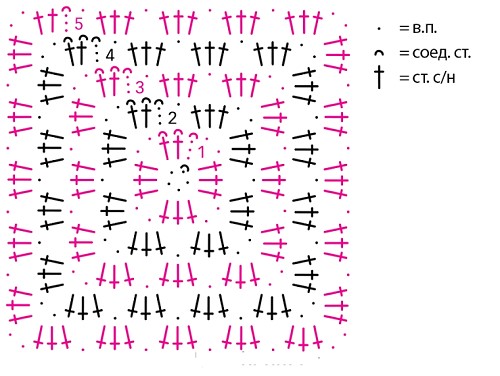
It is not necessary to knit with a single piece of fabric, you can make a snood from motifs. A "granny" square will be perfect. Having knitted the required number of elements, simply sew them into a long scarf, and then connect the ends.
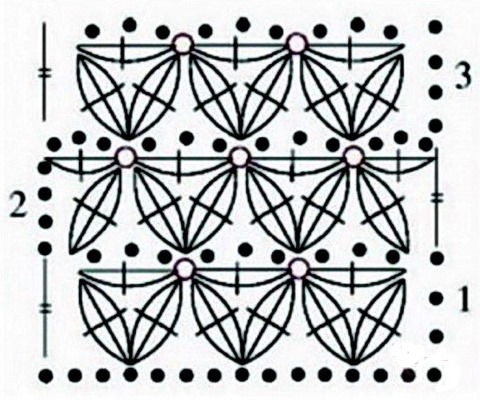
For winter items, a dense knitting pattern is required. For example, this pattern using thick yarn will result in a voluminous, warm snood, crocheted, that does not let in cold air.
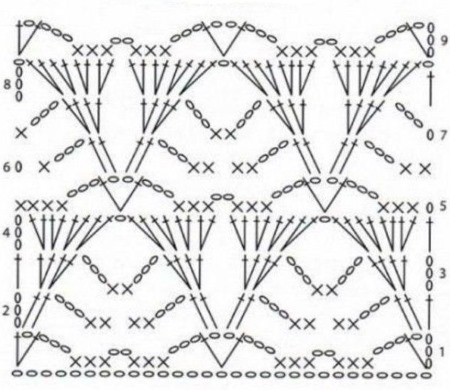
Crochet items can be for girls and boys. The difference is that the former love everything elegant and beautiful. Therefore, it is better to choose brighter yarn and a more intricate pattern, for example, as shown in the photo. In snoods for boys, a more restrained palette of shades and simplicity of the pattern are welcomed; openwork is unacceptable.
Article formatting:Natalie Podolskaya
Video about knitting a snood scarf
Video on how to crochet a snood scarf:
